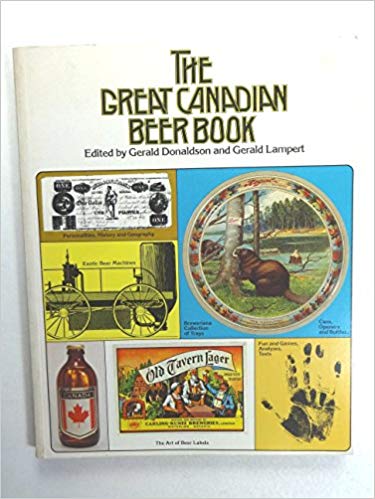The Great Canadian Beer Book, edited by Gerald Donaldson and Gerald Lampert, was issued in 1975 by respected publisher McLelland and Stewart, today part of Random House-Bertlesmann. Lampert is long-deceased while Donaldson has carved a notable career in auto race journalism and biography.
Despite its playful “scrapbook” design and insouciant tone, a genre of 1970s consumer publishing, the book is full of information: statistical, brewing-technical, historical, culinary, literary.
The first chapter, “How’s This for Openers”, pictures a pile of bottle openers. It’s funny, or was then!
The book comprises mainly short pieces by people of diverse backgrounds. There is Ted Dunal who ran a Henninger Brewery branch in Ontario in the 1970s. It made a clone of the German Henninger beer line.
Poets, journalists, ad executives, novelists, and professors have their beer say, while some chapters appear the product of the editors.
The book may be Canada’s first directed to beer fans as such. For that reason alone it deserves to be remembered, but has value beyond that. Recently, I discussed the late Marian Engel’s contribution. She was an award-winning Toronto-based novelist.
One essay offered important history on the Labatt Brewery. Photos depict a “replica of the original Labatt brewhouse built in 1828 in London, Ontario”. A bearded hippie type is shown grappling with an oak barrel. The picture evokes nothing so much as the modern craft brewery. Dumbly the future was being intuited.
Home-Made, Home-Brewed
A light-hearted yet informative chapter on home-brewing was written by Cromwell Kent. He noted:
… there is a barm [brewing yeast] in Toronto to soothe the weary soul. It is said to be descended from a famous Dublin brewery. Sometimes our barm dies on us, because we go a long time between brews and maybe we forget to feed it, and then we have to contact one of the custodians of this noble strain. They are all good people, deserving of their charge. Mostly they are artists and belong to what is nowadays called the Old Left. From the pictures on a person’s wall, a shrewd judge can tell if he is likely to have the barm.
Cromwell Kent was the pseudonym of British-born Francis Sparshott (1926-2015), long-time professor of philosophy and classics at the University of Toronto. An obituary in the Toronto Star gives a career overview, not omitting his interest in beer.
(One wonders what he thought of the craft beer revival, well underway at time of his passing. In his own way he, and his home-brewing cohorts, presaged it).
Kent had definite malty views – a true beer obsessive – and was particular on aging, especially. He felt 12-18 months made all the difference and after that, “who knows?” True enough, then or now.
American Bruits Beer, Here
The book addressed points of beer style even though the subject was much less evolved than today.
The second chapter, “My Love Affair With Beer”, was by James Lincoln Collier (JLC), an author and professional musician. He is known for a line of children’s books and other works, some written with his brother Christopher Collier.
JLC is an American, born and raised in New York City. Is it odd the opening essay of Canada’s first beer book was written by an American? Not really. We are two rather connected countries, beer is the least of it, in fact.
JLC had drunk beer, by his words, from “Dublin to Moscow…Rome to Oslo”. He evidently had a cosmopolitan and gastronomic background, not found on every corner then, the U.S. or Canada.
His multi-page essay is a blend of history, brewing technics, and reminiscence. Importantly, it includes a nugget on that modern stalwart of craft brewing, imperial Russian stout.
Strong London Stout
The first really “literary” treatment of imperial stout, which originates in Georgian London, is the 1960s magazine piece by a British drinks writer, “Cyril Ray Cracks a Bottle of 1948 Russian Stout”.
American beer writer Michael Weiner reprinted it in his 1977 The Taster’s Guide to Beer. Later that year Englishman Michael Jackson wrote his great éloge to Russian stout in the now-landmark The World Guide to Beer.
With the benefit of his historical investigations and literary ability, Jackson essentially created Russian or imperial stout as a cornerstone of the world beer palace, palais if you will.
Yet, JLC’s remarks predate Jackson’s by a good two years. In retrospect we can see JLC formed a bridge between Cyril Ray’s own writerly stylings and Jackson’s. Jackson always comes first but together they helped create the mystique that characterises imperial stout today.
So what did JLC say about Russian Stout?
He described it as “… heavy, bitter and musky, with overtones of funeral trombones and Wagnerian heroes at the edge of tragedy”. And further, “… its tragic grandeur makes it a truly majestic drink”.
Just wow, yes?
In those words, written as a cross-border book contribution almost 50 years ago, appears another presaging of craft beer culture, this time how we write about it.
Note re image: the image above was sourced from the Amazon listing linked in the text (see opening words). All intellectual property therein belongs solely to the lawful owner, as applicable. Used for educational and historical purposes. All feedback welcomed.

